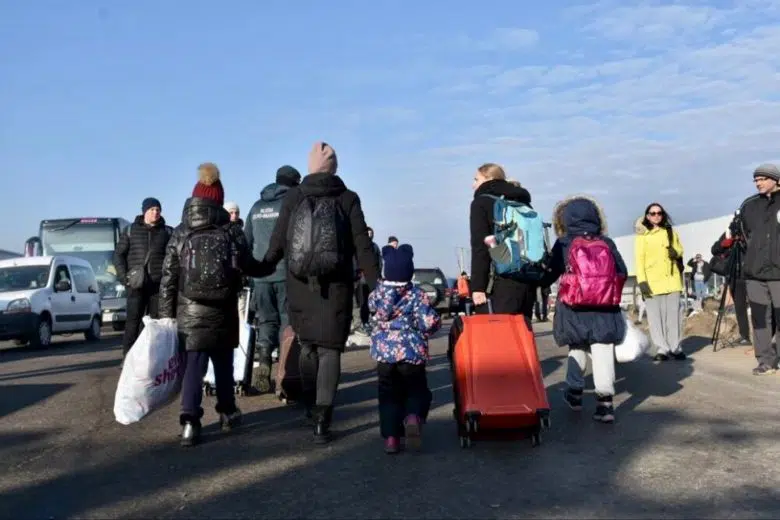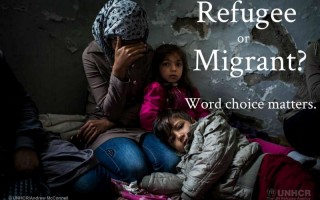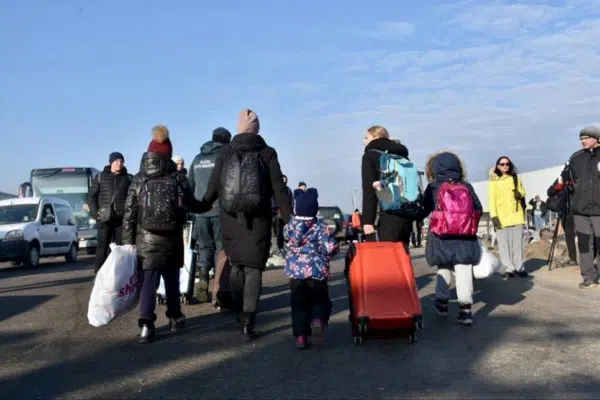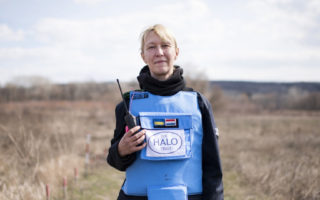
Families carry their belongings through the Zosin border crossing in Poland after fleeing Ukraine. © UNHCR/Chris Melzer
You may have heard or seen stories about the crisis in Ukraine. The amount of information can be overwhelming and confusing. What is happening in the region? Is humanitarian aid reaching those in need? Here are some answers:
When did this begin?
Ukraine has been impacted by many years of conflict and uncertainty. UNHCR, the UN Refugee Agency has been in Ukraine since 1994 and since the beginning of the conflict in eastern Ukraine in 2014, UNHCR has been working alongside partners to deliver protection and assistance on both sides of the contact line between Government controlled and non-Government controlled areas.
In early 2022, the conflict and military offensive escalated turning a volatile situation into a full scale, level-3 emergency, the highest level we have.
What is actually happening?
On February 24, 2022, a military campaign launched in Ukraine and endangered all who call the country home. Fearing for their safety, people fled, moving to other areas within the country or to countries that border Ukraine such as Poland, Slovakia, Moldova, and Romania, to protect themselves and their families.
Prior to the military offensive, almost three million people in Ukraine needed humanitarian support, including more than 850,000 people displaced by conflict.
As of mid-March 2022, more than 2.7 million people fled across Ukraine’s borders and more than a million more have been displaced within the country in what is an extremely volatile security and humanitarian situation.
The war in Ukraine has triggered the fastest-growing refugee crisis in Europe since the Second World War.
Who is being affected by the crisis?
In an attempt to seek safety, many have traveled via various methods, by car, train, bus or foot, to the nearest border country seeking refuge, or within Ukraine to areas deemed safer and less volatile.
The vast majority of those fleeing as refugees to neighbouring countries like Poland, Slovakia, Moldova, and Hungary are women, children and older people, as men ages 18-60 are asked to remain in Ukraine due to martial law.
Where is Ukraine?
Ukraine is located in the eastern part of Europe, with its largest border on the eastern part of the country connected to the Russian Federation. To the north west, Ukraine borders Belarus. To the west is Poland, Slovakia, and Hungary. Finally, to the south is Romania and Moldova. The majority of refugees from Ukraine have fled to Poland, while Slovakia, Hungary, Romania and Moldova have also received many refugees. Some refugees from Ukraine are continuing to other European countries and beyond, where they may have family connections.
What Is UNHCR Doing?
The United Nations High Commissioner for Refugees (UNHCR), also known as the UN Refugee Agency, is working to support those affected by the crisis in Ukraine.
UNHCR has offices in six locations in Ukraine and a longstanding presence in the region, working with national authorities on refugee related matters Poland, Romania, and Hungary, Slovakia, Slovenia and the Czech Republic under a multi-country office in Budapest. We have
reinforced our operations in Ukraine and around, sending more resources, expert staff and stockpiles of emergency supplies in various locations.
In Ukraine, despite ongoing hostilities, UNHCR remains operational and is making its stocks of core relief items available to be distributed across the country. These items include blankets, kitchen sets, jerrycans, solar lamps, and shelter materials to reinforce damaged buildings. UNHCR’s teams continue to provide protection services such as psychosocial support and are setting up innovative ways to get emergency cash into people’s hands.
In all neighbouring countries, UNHCR is present at border areas and reception centres to help identify and provide dedicated care to the most vulnerable refugees and set up helplines and information materials for people forced to flee. With partners, UNHCR is setting up the ‘Blue Dots’, safe spaces which provide a minimum set of protection services for children, families and others with specific needs, in support of existing services and government efforts.
In Poland and the Republic of Moldova we have been providing core relief items such as warm blankets, and transport assistance from Moldova to Romania to help refugees reach reception areas. We have also begun distributing cash assistance to the most vulnerable, enabling them to buy the essentials they need like food, medicine and temporary accommodation.
Working in conjunction with our partners, UNHCR is rapidly scaling up relief efforts in every way possible to provide safety and resources to those who are being displaced by the crisis in Ukraine.
How Can You Help?
- Be objective and look for reputable news sources
- Share links and resources to help those who are fleeing the crisis (https://help.unhcr.org/)
- Make a donation to UNHCR’s Ukraine relief efforts
- Start your own fundraiser
- Share this post on social media to help to get the word out to others
Find out more ways you can help Ukraine in our post here.





